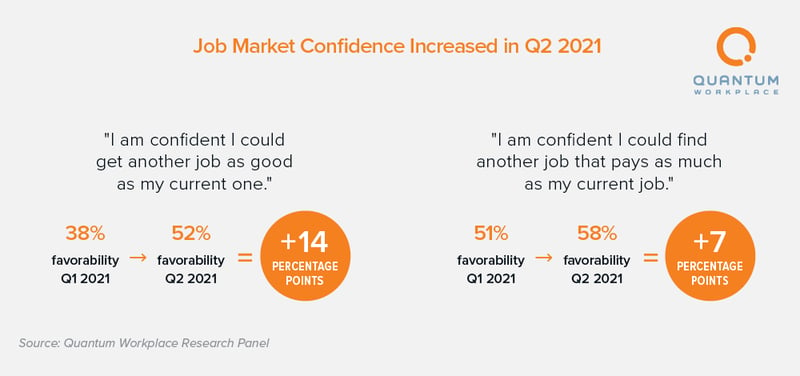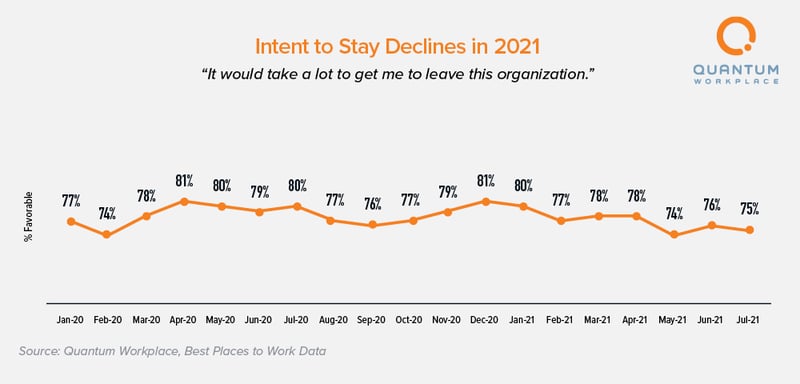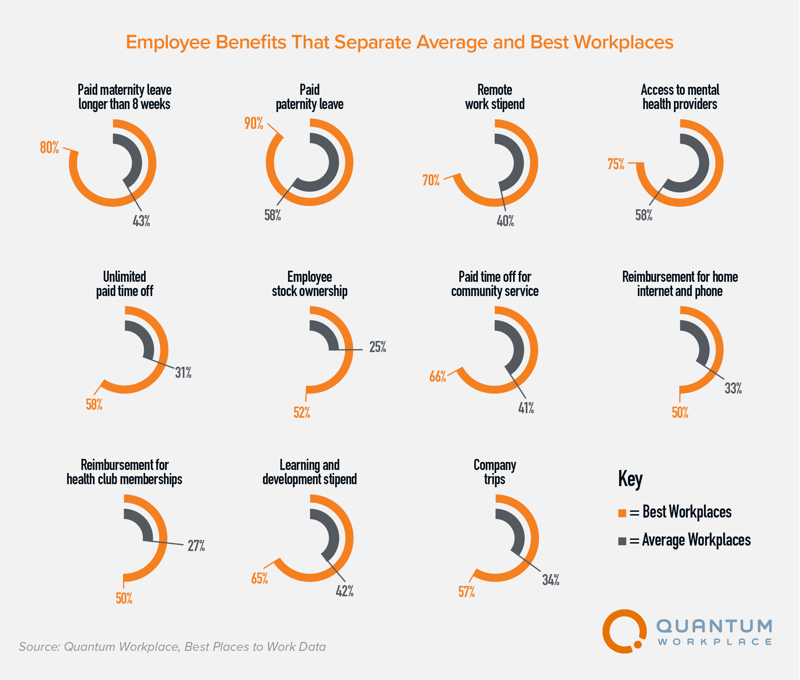Employee Turnover and Retention Trends
Retaining and recruiting top talent has become increasingly important, but difficult, after the tumultuous events of 2020. The Great Resignation has disrupted the momentum of business and negatively impacted organizational culture for many companies.
Employees are looking for a change from their current jobs, while low unemployment rates have prompted large gaps in the job market. High turnover rates have pushed organizations to look for solutions to best retain their employees and attract top talent.
Learn more about the data behind this report, supplied by Quantum Workplace.
The costs to replace talent can fluctuate drastically depending upon the industry, position, and level of talent that needs to be replaced. According to SHRM, these estimates range from one half to two times the departing employee’s salary.
In addition to replacement costs, organizations lose valuable expertise and company knowledge from departing employees, while the team members of exiting employees who stay often report lower morale. The loss of top performers, team cohesion, and hard-to-fill positions can affect business outcomes indefinitely.
This report will help you gain insight into best practices for navigating these unprecedented times to overcome your unique turnover and retention challenges.
The Economy and Its Impact on Turnover and Retention
The health of the economy has fluctuated dramatically during the COVID-19 crisis. At the onset, economic uncertainty, recession, and preventative lockdowns forced many organizations to reduce their workforce and slow hiring.
In more recent months, the job market has recovered at a fast pace. Employees who are already burnt out and unsatisfied with their jobs have more opportunities to change careers or even leave the workforce entirely.
Unemployment Rates Declining in 2021
In April 2020, the workforce experienced an influx in unemployment at an almost 15 percent unemployment rate. As of August 2021, this rate has declined to 5.2 percent, meaning unemployment is no longer a threat for most employees—but employee retention and recruitment have become a looming issue for many organizations.
Voluntary Quit Rate is Increasing
In April of 2021, 4 million employees left their organizations voluntarily. And that rate has remained elevated with another 3.9 million employees leaving voluntarily in June of 2021. This mass exodus has created a surplus of open jobs that need to be filled and has left organizational leaders scrambling to retain their best and difficult-to-replace employees.
Peak Job Openings Prompt Job Market Confidence
The rate of job openings has increased to 6.9 percent in June 2021 from a pandemic low of 3.4 percent in April of 2020. In July, there were 9.8 million job vacancies but only 8.7 million potential employees who were looking for employment. This indicates that there are more available jobs in the economy than workers who are seeking to fill those positions. The strong job market has generated an increase in employee confidence due to the number of opportunities now available to them.
Employees’ Confidence in the Job Market is on the Rise

Employees’ confidence in the job market has increased throughout 2021. In fact, a majority of employees (58 percent) report confidence in finding another job that pays as much as their current one. Additionally, 52 percent of employees are confident they could find another job that they believe is as good as their current one.
Employees’ Intent to Stay Peaked in 2020
While job market confidence among employees is currently high, this was not the case in 2020. COVID-19 brought a sense of job uncertainty for many employees, leaving them unable or apprehensive to switch jobs or organizations.
In 2020, 81% of employees reported it would take a lot for them to leave their organization.
In fact, 81 percent of employees reported it would take a lot for them to leave their organization in April, and again in December 2020. However, as many have adjusted to the realities of the pandemic, employees are feeling less loyal to their current employers.
Employees’ Intent to Stay Declining in 2021

Employees' intent to stay has been decreasing in 2021. Job uncertainty is no longer a pressing issue, prompting a decline from their peaks in April 2020. By May 2021, only 74 percent of employees agreed that it would take them a lot to leave their current organization.
As unemployment rates decline and job market confidence rises, employee turnover is more likely to increase. This has led many leaders to refocus on employee retention strategies as the competition for talent becomes more intense.
Highly Engaged Employees are More Likely to Stay
Our research shows that employees who are engaged and invested in their work are more likely to stay at their organizations.
88 percent of highly engaged employees agree that they will be at their organization in a year, compared to 49 percent of disengaged employees.
In fact, employees who are highly engaged are 1.8 times more likely to say that they will be working at their current organization a year from now, compared with those who are not highly engaged. Moreover, highly engaged employees are 4.4 times less likely to be actively applying and searching for other jobs.
The power of employee engagement as a retention mechanism is apparent as there is a high correlation between engagement and intent to stay. This highlights the importance of centering your retention strategy around the employee experience.
6 Primary Reasons Employees Leave
When organizations don’t invest in the areas that most drive engagement, they might risk increased turnover. After analyzing exit surveys from thousands of departing employees, we’ve identified the top 6 reasons behind employee resignations.
1. Poor Leadership Communication.
Many exiting employees said their leaders failed to communicate effectively. In fact, only 35 percent of exiting employees said they experienced transparent communication throughout all levels of the organization. When leadership communication is inconsistent, employees often feel uninformed and misaligned. Employees may fill in the gaps, lose a sense of connection, or become uninspired.
35 percent of exiting employees said they experienced transparent communication throughout all levels of the organization.
To ensure your teams are on the same page and understand your organizational initiatives, provide transparent communication throughout your organization. Leaders need to prioritize consistent communication with their employees. Create channels and systems that make frequent, two-way communication a reality. The right tools can help leaders and teams connect more consistently, clearly, and effectively.
2. Lack of Employee Recognition
Consistent recognition is a key driver of employee engagement and retention. But employees are experiencing a lack of appreciation for their efforts. In fact, only 43 percent of exiting employees said they felt valued by leaders at their organization, alluding to insufficient and irregular recognition efforts.
43 percent of exiting employees said they felt valued by leaders at their organization.
Incorporate a variety of ways to regularly show your appreciation for your employees’ efforts—big or small. Leverage team-wide, individual, peer-to-peer, and public and private praise. With accepted practices and expectations for giving recognition, you can prioritize your initiatives to make consistent employee recognition the norm.
3. Lack of Career Growth and Development.
The best talent wants to continuously grow and develop in their careers. But only 38 percent of departing employees said they saw professional growth and career development opportunities for themselves at their organizations. Also, only 45 percent of exiting employees said their job was in alignment with their career goals. If employees don’t see growth or don’t feel their work aligns with their talent or interests, they are likely to seek other opportunities.
38 percent of departing employees said they saw professional growth and career development opportunities for themselves at their organizations
Leverage consistent 1-on-1s with employees to ensure your organization is meeting employees’ growth needs and goals to reduce employee flight risk. Provide opportunities for coaching and mentorship through online training sessions and webinars, stretch assignments, certifications, and cross-training.
Invest in these growth opportunities to communicate your understanding of your employees’ potential and close internal skill gaps. To further drive employee engagement and retention, prioritize internal hiring and promotions when possible.
4. Insufficient Work-Life Balance and Flexibility.
Employees seek flexibility—they need an organization that allows them to effectively juggle their overarching day-to-day responsibilities outside of work. But only 56 percent of exiting employees said that their job allowed them to meet the needs of both their work and personal life.
Employees who are given ample flexibility are 4 times less likely to become a retention risk.
When organizations don’t offer sufficient flexibility, the inability to balance life stressors often leads to employee turnover. Employees who are given ample flexibility are 4 times less likely to become a retention risk.
To keep employees happy, leverage the flexibility that your employees need. Consider adopting new policies and procedures to boost your workplace flexibility. Safeguard your employees’ work-life balance and retain top talent by re-evaluating your flexibility initiatives.
5. Inadequate Employee and Leadership Feedback.
When leaders fail to ask for feedback or respond with meaningful action, problems often arise. But only 48 percent of departing employees said that when they give feedback to management, it is well received and followed up on.
When avenues to give feedback are lacking and visible change is rarely made, employees are likely to bottle up their opinions and suggestions—which makes it harder for leaders to understand or improve the employee experience. And when improvements aren’t made, tension builds, and employees often leave.
48 percent of departing employees said that when they give feedback to management, it is well received and followed up on.
Employees need channels to provide meaningful feedback, but they also need the right channels to receive feedback too. But only 57 percent of employees said their immediate manager regularly gave them constructive feedback about their job performance.
Constructive performance feedback is a must-have when it comes to engaging your employees, as employees are 2 times more likely to be highly engaged when they agree that their manager regularly gives them feedback to improve their performance. Employees who regularly receive constructive feedback are also less likely to be searching for other jobs and 2 times more likely to say they will be working at their current company in the next year.
Employees are 2 times more likely to be highly engaged when they agree that their manager regularly gives them feedback to improve their performance.
Without ample feedback or follow-up in place, organizations run the risk of remaining stagnant. Employees need feedback to understand what they are doing well and what they can improve upon to drive their career developmental goals.
Welcoming and giving consistent, helpful feedback should be top of mind. When meaningful action is taken as a result, these two approaches will help employees feel heard, valued, and on a path to success at your organization. And with effective feedback strategies in place, employees are more likely to stick around for the long haul.
6. Lack of Competitive Benefits.
Our research shows the benefits top workplaces offer to attract and retain their employees. Employees aren’t leaving for wages alone—many are reshaping what they prioritize in an employer including the organization’s mission, purpose, values, and benefits offered.
Consider reshaping your employee value proposition and recognizing the importance of your employees’ by providing benefits and rewards that meet their needs.

4 Tools for Your Employee Retention Strategy
While it may be tough to adjust to your employees' needs, there is an array of tools that leaders can leverage to better meet these needs and drive employee engagement. Enable your organization to give employees what they want, with tools that amplify and strengthen your attraction and retention initiatives.
1. Employee Listening Tools.
The best organizations leverage employee engagement, pulse, and lifecycle surveys as part of their comprehensive employee listening strategy. These are valuable tools that give insight into the thoughts and perceptions of employees to provide better support, improve performance, and reduce flight risk.
Leverage employee engagement software that streamlines various types of employee surveys. By taking advantage of a robust platform, your employee surveys will be easily implemented and provide valuable intel to inform action that elevates employee engagement and business success.
2. Employee Recognition.
Create an organizational culture that prioritizes employee recognition as a regular practice. Peer-to-peer recognition and public and private praise from managers are helpful tools to make your employees feel valued and reduce turnover.
Leverage employee recognition software that allows employees to share recognition organization-wide. This keeps teams connected and increases visibility to the impact that individual contributions have on team and business success.
3. Flight Risk Intelligence.
Leverage flight risk intelligence tools to gain insight into who is at risk for turnover. Uncover analytics that help you determine which employees are at a low, moderate, or high flight risk and why.
Employees identified as high flight risk in Quantum Workplace’s software are 4 times more likely to leave their organization within 1 year. To best avoid retention issues, look to people analytics tools that give you warning signs when top performers are likely to leave.
4. Exit and Stay Surveys and Interviews.
95 percent of employees believe they can help leaders understand why they left their organization. Uncover insights into why employees are leaving so you can be proactive in organizational improvement and tackling turnover.
87 percent of employees believe collecting feedback from exiting employees will help improve the experience for remaining employees. Whether your organization experiences high or low turnover, gaining these insights is important to combat organizational practices that negatively affect the employee experience.
Gaining these insights before employees leave is important too. Leverage stay surveys and interviews as a preventative measure. Drive your retention initiatives with tools that help leaders uncover why their top performers might leave the organization, before they depart.
Conclusion
The unique retention and turnover challenges throughout 2020 and 2021 have made organizational leaders reflect on the internal practices that drive engagement and retention. To retain your top performers, ensure your retention strategy is focused on employee engagement. Ultimately, your employees’ success will drive business success.
Survey Methodology
The research from this report was derived from the Best Places to Work contest—powered by Quantum Workplace. This nationwide contest measures the employee experience of over 1 million voices across thousands of the most successful organizations in the United States. From this respondent pool, we conduct an opt-in, independent research panel with over 32,000 individuals who share their workplace experiences. This unique vantage point gives us the ability to understand workplace trends to supply insights that help other organizations succeed.






